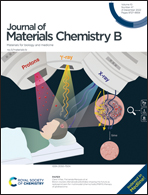Black graphitic carbon nitride nanosheets with mid-gap states realizing highly efficient near-infrared photo-thermal conversion for photoacoustic imaging†
Abstract
Developing metal-free photo-thermal transduction nanoagents (PTNAs) with high conversion efficiency addresses the balance between superior photothermal performance and good biocompatibility in the field of bio-applications of PTNAs. Herein, we highlight the bandgap-engineered black graphitic carbon nitride nanosheets (denoted as B-g-C3N4) as a novel metal-free PTNA with high conversion efficiency (62% at 808 nm) for photoacoustic imaging. The B-g-C3N4 absorbed infrared light with a narrowed bandgap and electronic states within the band (known as mid-gap states) due to the synergistic effect of sulfur incorporation, nitrogen vacancies and the porous structure. Notably, the mid-gap states mediated the non-irradiative recombination of electrons and holes, bringing about energy dissipated as phonons. Owing to the high conversion efficiency as well as superior biocompatibility, HeLa cells incubated with B-g-C3N4 can be ablated under 808 nm light illumination. Furthermore, the B-g-C3N4 realized cross-sectional multispectral optoacoustic tomography (MSOT) imaging of the U14-tumor-bearing mouse. This work expands the catalogue of highly efficient metal-free PTNAs, showing great promise in biological applications.



 Please wait while we load your content...
Please wait while we load your content...